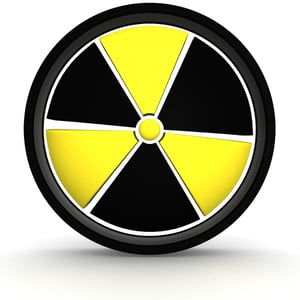If you’re a company that uses Class 5 oxidizers, care must be taken to avoid a potentially dangerous environment.
That’s because hazardous waste Class 5 oxidizers readily yield oxygen in reactions. This can enhance the threat of combustion and pose a dangerous situation for your employees.
Below, we’ll explore some of the most frequent questions that address:
- What Class 5 oxidizers are
- How they should be handled
- How they should be disposed
- What to do in the event of a spill
What Are Class 5 Oxidizers?
The Department of Transportation uses a classification system that organizes hazardous chemicals and materials into different groups, referred to as classes.
Examples of classes include explosives, gases, flammable solids and radioactive materials. Class 5 oxidizers is another example of hazardous materials class your business may use.
Class 5 is divided into two sub-classes:
- Class 5.1 Oxidizing substances
- Class 5.2 Organic peroxides
 Class 5.1 Oxidizing substances are not necessarily combustible themselves. However, by yielding oxygen, they can cause or contribute to the combustion of another material.
Class 5.1 Oxidizing substances are not necessarily combustible themselves. However, by yielding oxygen, they can cause or contribute to the combustion of another material.
Examples of Class 5.1 Oxidizing substances include:
- Ammonium nitrate
- Potassium nitrate
- Nitric acid
- Pool chemicals (sodium hypochlorite)
- Halogens
- Potassium bromate
Class 5.2 Organic peroxides are substances that contain the bivalent -O-O- structure and may be considered derivatives of hydrogen peroxide. One or both hydrogen atoms have been replaced by organic radicals.
Organic peroxides are thermally unstable. They may undergo self-accelerating decomposition and may present hazardous conditions in the workplace, since they:
- Are liable to explosive decomposition
- Burn rapidly
- Are sensitive to impact or friction
- Can react dangerously with other substances
- Can cause eye damage
How Should They Be Handled?
Although oxygen itself isn’t necessarily hazardous, the production of oxygen in high concentrations is extremely dangerous.
In the event of a fire or chemical reaction, the presence of oxidizers can lead to massive combustion of an otherwise small, contained chemical event. This video shows the energetic reaction between an oxidizer and organic compound.
Because oxidizers are so hazardous and reactive, they need to be handled in a very specific way.
If your employees must handle oxidizers in your facility, it’s important that they:
- At a minimum wear standard laboratory attire, which consists of closed-toe shoes, long pants, a lab coat, safety glasses with side shields or splash goggles, and gloves.
- Seek more specific information on the reactivity of particular chemicals when a procedure requires mixing a strong oxidizer with an organic chemical. Mixing can result in a violent reaction.
- Use oxidizers in a chemical fume hood. If there is a risk of explosion or violent reaction, it is absolutely necessary to use the hood sash as a protective barrier between you and the hazard.
- Not return excess chemicals to its original container. Contamination of the material could cause an unwanted and dangerous reaction.
How Should They Be Disposed Of?
For this reason, oxidizers should only be handled by highly qualified waste disposal specialists. Specialists will:
- Dispose of oxidizers separately from wastes that are flammable or easy to burn, such as paper, gasoline or wood.
- Seal tightly oxidizers in durable, leak-free containers.
- Transport oxidizers to appropriate disposal facilities and ensure any cradle-to-grave requirements are met.
Disposal specialists also will ensure all requirements are met for proper disposal. Improper disposal of hazardous waste can take many different forms. One of the most basic and common forms of improper waste disposal for Class 5 oxidizers is failing to store and label the waste.
All Class 5 oxidizers should be stored to meet federal guidelines enforced by the Department of Transportation. Shipping requirements when transporting these hazardous materials, may include:
- A shipping manifest: In 2018, the Environmental Protection Agency began implementing a national e-manifest system that tracks hazardous waste shipments electronically. For several decades, the EPA has imposed a manifest system that tracks cradle-to-grave hazardous waste.
- The proper hazardous waste labels and placards: The DOT requires hazardous waste generators to label and mark each package of waste before transporting off site. The Class 5.1 placard, is entirely in yellow and features an oxidizer symbol, while the Class 5.2 placard is half yellow, half red, and features a flammable symbol in the red section.
- California requirements: The California Department of Toxic Substances Control (DTSC) also provides its own set of requirements that generators must follow, including:
- The composition and physical state of the waste
- A statement that calls attention to the hazardous properties of the waste
- Name and address of the generator
What If An Emergency Occurs?
 In the event of an accident or emergency involving Class 5 oxidizers, keep the following safety tips in mind:
In the event of an accident or emergency involving Class 5 oxidizers, keep the following safety tips in mind:
- Skin contact: Remove contaminated clothing and rinse the affected skin immediately with copious amounts of water for 15 minutes or until pain is relieved. Seek medical attention if the skin is irritated or pain is felt, or if the chemical is highly toxic.
- Eye contact: Use the eye wash to rinse the eye thoroughly for at least 15 minutes, occasionally lifting upper and lower eyelids and rolling the eyeballs. Seek medical attention.
- Inhalation: Move into fresh air immediately. Seek medical attention.
- Ingestion: Do not induce vomiting. Rinse the mouth with water. Seek medical attention.
If any of the above situations occur, make sure you provide the medical team with the Safety Data Sheet (SDS) for the chemical. Always consult with the SDS for emergency procedures specific to the chemical you are using.
If a spill occurs, sweep up spills of solid oxidizers carefully with a broom and dustpan. Collect the material in a container with lid. Liquid spills can be cleaned up with inert absorbent pads (no organic material). If the liquid oxidizer is an acid, the spill should first be neutralized with sodium bicarbonate.
Bottom Line
Because oxidizers can be reactive, they should be disposed of by highly qualified waste disposal specialists to:
- Eliminate your liability through cradle-to-grave requirements,
- Minimize workplace and environmental risks, and
- Assist you with staying on top of government regulation changes that can affect your ability to do your job effectively.
Be sure to work with a hazardous waste disposal company that is properly licensed and trained to handle emergency situations. Waste removal specialists should know exactly what to do in the event of any kind of spill to ensure the safety of your facility, staff and others around you.
Image Credit: Photo by Matt Soar | CC BY

Comment